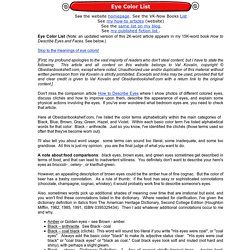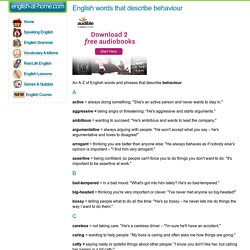

Writing to Describe. How to Describe Eyes. How to Describe Eyes (An updated version of this 2K-word article is reproduced in my 15K-word book How to Describe Eyes and Faces. See below.) [First, my profound apologies to the vast majority of readers who don't steal content, but I have to state the following. This article and all content on this website belongs to Val Kovalin, copyright © Obsidianbookshelf.com, except where noted. Unauthorized use and/or duplication of this material without written permission from Val Kovalin is strictly prohibited. Excerpts and links may be used, provided that full and clear credit is given to Val Kovalin and Obsidianbookshelf.com with a return link to the original content.] Even though I recommend "less is more" with physical description in fiction, I love descriptions of characters' eyes: eye-color and other attributes. Go to the Eye Color List (separate page) Go to the Eye-Color Images (further down on this page) How to Write a Good Description.
The Eye-Color Images. What about the gray eye? Eye Color List. Eye Color List (Note: an updated version of this 2K-word article appears in my 15K-word book How to Describe Eyes and Faces.

See below.) Skip to the meanings of eye colors! [First, my profound apologies to the vast majority of readers who don't steal content, but I have to state the following. This article and all content on this website belongs to Val Kovalin, copyright © Obsidianbookshelf.com, except where noted. Unauthorized use and/or duplication of this material without written permission from Val Kovalin is strictly prohibited.
Don't miss the companion article How to Describe Eyes where I show photos of different colored eyes, discuss clichés and how to improve upon them, describe the appearance of eyes, and explain some physical actions involving the eyes. Here at Obsidianbookshelf.com, I've listed the color terms alphabetically within the main categories of Black, Blue, Brown, Gray, Green, Hazel, and Violet. Amber or Golden eyes – see Brown - amber. Black. Blue. Describing a person - adding descriptive elements and well-chosen details. English words that describe behaviour.
An A-Z of English words and phrases that describe behaviour. active = always doing something: "She's an active person and never wants to stay in.

" aggressive = being angry or threatening: "He's aggressive and starts arguments. " ambitious = wanting to succeed: "He's ambitious and wants to lead the company. " argumentative = always arguing with people: "He won't accept what you say – he's argumentative and loves to disagree! " arrogant = thinking you are better than anyone else: "He always behaves as if nobody else's opinion is important – "I find him very arrogant.
" assertive = being confident, so people can't force you to do things you don't want to do: "It's important to be assertive at work. " bad-tempered = in a bad mood: "What's got into him lately? Big-headed = thinking you're very important or clever: "I've never met anyone so big-headed! " Words to Describe a Person.
In our daily lives, we come across a lot of people with whom we may or may not interact. A few of them become acquaintances and some even become friends over time. Then again, there are some that give off unfavorable vibrations or are simply repulsive. Also, in our social circles, we have friends, relatives, colleagues, seniors, etc., each of whom has a unique set of attributes that are a part of his/her individual personality. These attributes are often highlighted to summarize an individual's personality or most striking trait. Below is an alphabetical list of words that can be used to describe a person in terms of his/her qualities and the impression he/she has left on you. Deliverance from Descriptive Dilemma The following lists are not exhaustive, but you will get a lot of common as well as not-so-common words, under each alphabet, to describe someone. AcrimoniousAdorableAdventurousAccomplishedActiveAdmirableAdolescentAdorable AvidAgedAggressiveAncientAngelicArrogantArticulateAwful.
How to Describe a Smell: 10 steps (with pictures) Edit Article Sample Descriptions of Smells Edited by Dvortygirl, Krystle, Sondra C, Martyn P and 26 others We have plenty of words to describe other senses and sensations, but smell seems to defy words.

The human sense of smell is not heavily developed compared to that of many animals. Still, it's a deep and rich sense, and it can enhance how you communicate (especially when you're crafting a story or describing a moment), how you experience your other senses (particularly taste), such as when tasting complex flavors in wine and dark chocolate, and even with determining when fruit is ripe or milk is spoiled.
Ad Steps 1Identify your reason for describing the smell. 9Consider what feelings and emotions a smell evokes, especially if you are using it as a literary device. Sample Descriptions of Smells Tips Learn the vocabulary of smells relating to those smells that interest you, see how others describe those smells. Warnings Some smells signal hazards.